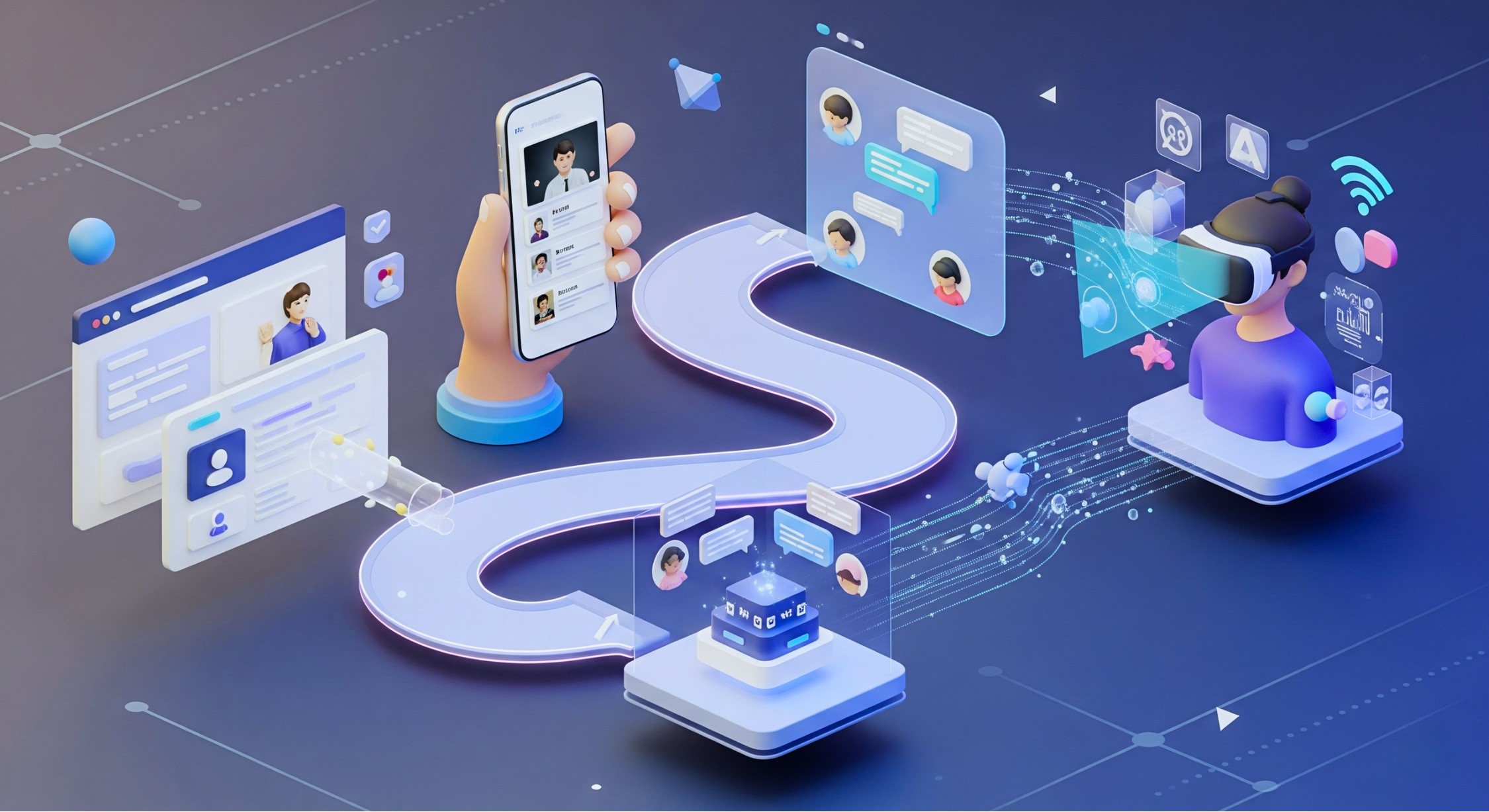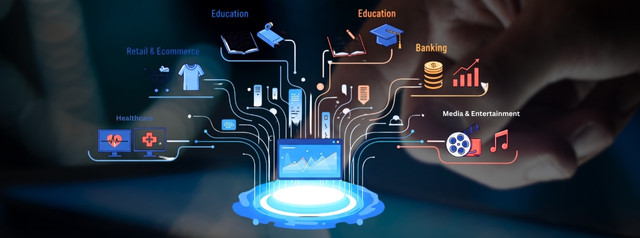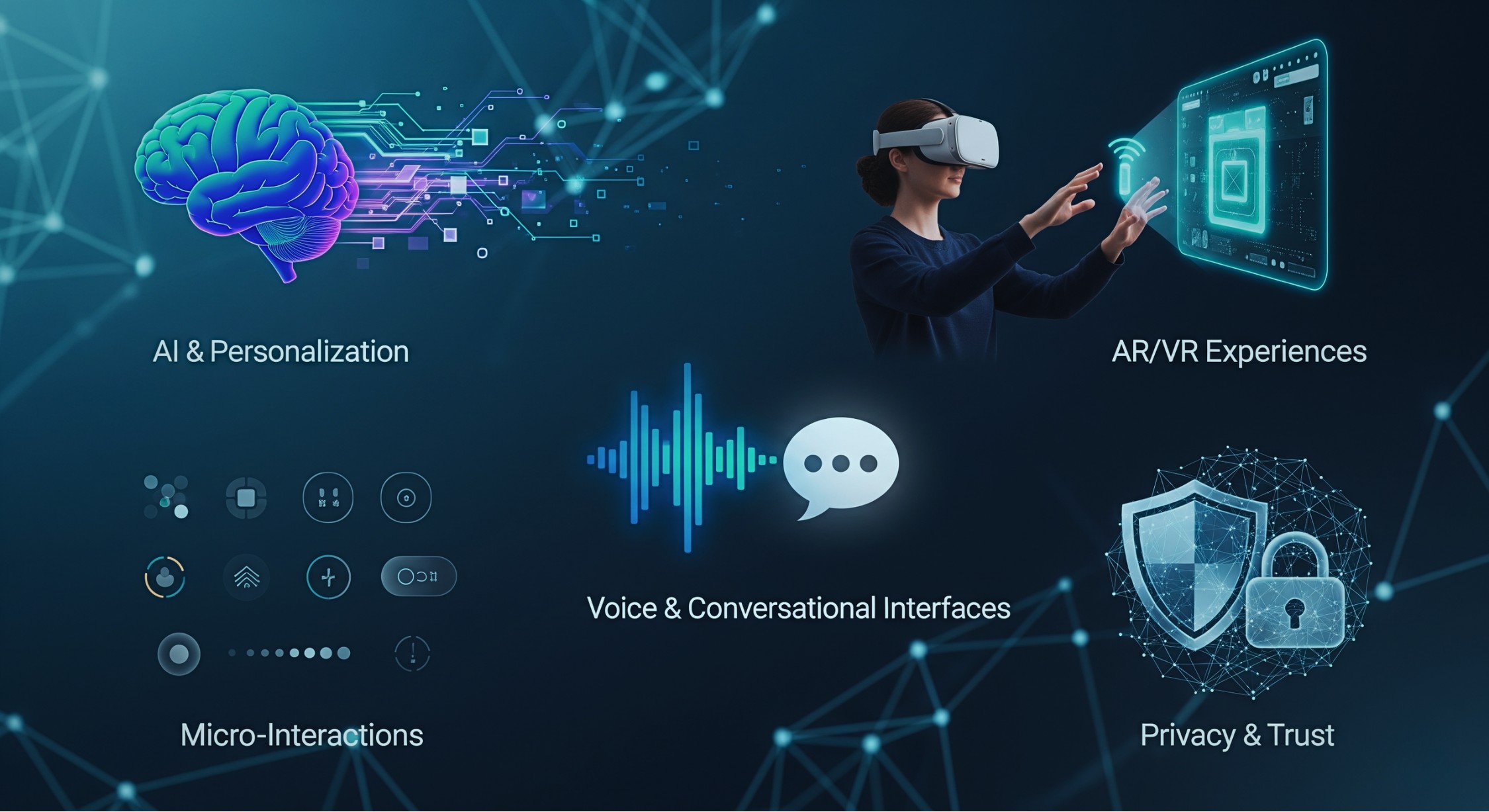At Experion Technologies, we see digital experiences as more than just polished designs or functional interfaces, they are the bridge between human needs and technological innovation. Every interaction—whether a click or swipe—presents an opportunity to connect, inspire, and add value. Our approach blends intuitive design, deep data insights, and cutting-edge technology to create user-first solutions that do more than meet expectations, they build lasting relationships and measurable business impact.
Today’s customers engage with brands across a growing mix of touchpoints, websites, mobile apps, chatbots, social platforms, and even emerging channels like AR/VR or voice assistants. These interactions are no longer isolated events; they form a continuous journey that shapes perceptions and influences loyalty. Delivering seamless, personalized, and consistent experiences across this journey is not just a competitive advantage, it is essential.
The right digital experience strategy aligns creativity, technology, and analytics to ensure that every interaction, whether browsing a product online, booking a service on a mobile app, or engaging with a brand’s social content, feels natural, relevant, and impactful. When done well, it transforms casual users into brand advocates, strengthens market presence, and drives sustainable growth.
What is Digital Experience?

A digital experience is the complete journey a customer takes when interacting with a brand through digital channels. This can include websites, mobile applications, chatbots, immersive AR/VR environments, and even voice-activated assistants. It goes beyond just functionality to encompass the emotions, perceptions, and value a customer derives from each touchpoint. Unlike traditional customer experiences, which primarily focus on in-person or offline interactions, digital experiences merge advanced technology, creative design, and behavioral insights to deliver relevant, context-aware engagement in real time.
Core Elements of Digital Experience
- Usability: The foundation of every successful digital interaction is ease of use. Clear navigation, logical workflows, and intuitive design allow customers to achieve their goals without friction or confusion.
- Personalization: Customizing content, offers, and features based on individual user preferences and behaviors creates a sense of relevance and connection, encouraging deeper engagement.
- Engagement: Interactive elements, compelling visuals, and immersive storytelling keep users actively involved, turning routine interactions into memorable moments.
- Accessibility: Designing with inclusivity in mind ensures that all users, regardless of abilities or devices, can enjoy a seamless experience. Accessibility is not just a legal requirement in many regions, it is a mark of a brand that values all its customers.
- Performance: Speed and reliability are critical to maintaining trust. Fast-loading pages, responsive layouts, and stable functionality keep users engaged and prevent frustration.
Why It Matters?
A strong digital customer experience plays a central role in building brand loyalty, reinforcing brand identity, and driving long-term business growth. When customers feel understood, valued, and supported throughout their interactions, they are more inclined to return, recommend the brand to others, and increase their overall spending. Businesses that prioritize delivering exceptional digital experiences position themselves to stand out in competitive markets, adapt to evolving customer expectations, and create lasting relationships that drive measurable results.
Let’s turn every click into a memorable experience.
Connect with us today!
Growing Relevance of Digital Experiences in Various Industries

The impact of digital experiences is being felt across every sector as customer expectations continue to evolve. Businesses that invest in delivering seamless, engaging, and personalized interactions are seeing measurable gains in customer satisfaction, loyalty, and revenue growth.
- Retail & Ecommerce: Customers now expect shopping experiences that feel tailored to them. AI-powered personalization delivers product recommendations that align with their preferences, while streamlined checkout processes reduce cart abandonment. Omnichannel engagement ensures that whether a customer is browsing online, using a mobile app, or visiting a physical store, the experience feels consistent and connected.
- Education: Learning is no longer confined to the classroom. Interactive learning platforms, virtual classrooms, and adaptive content create engaging and personalized educational experiences for students of all ages. By integrating gamification and real-time feedback, educators can keep learners motivated and on track.
- Healthcare: Patients increasingly expect digital services that are as smooth and secure as other online experiences. Secure patient portals allow easy access to health records, telehealth solutions make remote consultations possible, and appointment management tools simplify scheduling, improving both patient satisfaction and healthcare provider efficiency.
- Banking and Finance: Digital transformation in financial services has shifted customer expectations toward convenience and speed. Intuitive mobile banking apps allow instant access to accounts, AI-driven financial planning tools offer personalized advice, and robust security measures ensure safe transactions while maintaining user trust.
- Media and Entertainment: Streaming services, online gaming, and digital publishing have redefined entertainment consumption. On-demand access, personalized playlists, and interactive storytelling allow audiences to curate their own experiences, leading to deeper engagement and loyalty.
Understanding Digital Experience Platforms
A digital experience platform (DXP) is a unified suite of tools designed to help businesses manage, deliver, and optimize digital content and interactions across multiple channels. It provides the infrastructure needed to maintain consistent branding, messaging, and functionality whether a customer interacts through a website, mobile app, or social platform.
DXPs often integrate with digital experience analytics platforms that track and analyze user behavior, providing actionable insights for continuous improvement. They also work in tandem with digital experience management systems to ensure that updates, campaigns, and new features are deployed seamlessly across all touchpoints.
By consolidating content management, personalization, analytics, and delivery into one cohesive framework, a DXP enables brands to offer high-quality, scalable, and connected experiences. Businesses that adopt these platforms are better equipped to adapt to shifting customer expectations, integrate new technologies quickly, and maintain a competitive edge in their industries.
Crafting Impactful Digital Experience Design

Digital experience design is the art and science of blending creativity, technology, and user-centric thinking to create interactions that truly resonate with the audience. It is not just about ensuring that a product or service works, it is about crafting a journey that feels intuitive, memorable, and emotionally engaging. Every click, scroll, and interaction should contribute to an experience that reflects the brand’s identity and builds a lasting connection with the user.
Principles of Effective Design
- Consistency across touchpoints: Maintaining a uniform look, feel, and messaging across websites, mobile apps, email campaigns, and other channels helps reinforce brand identity. It builds user familiarity and trust, making every interaction feel connected and intentional.
- Accessibility and inclusivity: Designing for all users, regardless of ability or device, ensures equitable access to products and services. This not only broadens the reach of digital experiences but also reflects a brand’s commitment to diversity and inclusion.
- Emotional engagement and storytelling: Stories are powerful tools for building relationships. Incorporating narrative elements, relatable scenarios, and visually rich content can transform functional interfaces into experiences that inspire loyalty.
- Data-driven personalization: Leveraging analytics and behavioral insights enables experiences that adapt in real time to user preferences, creating a sense of relevance and value at every interaction.
Tools & Technologies
The right toolkit empowers design teams to innovate and iterate efficiently. Advanced UX/UI design tools such as Figma and Adobe XD enable collaborative design and prototyping. Prototyping platforms allow rapid testing of new concepts, while digital experience analytics platforms like Google Analytics and Hotjar provide actionable insights into user behavior. By combining design creativity with robust analytics, brands can refine experiences continuously for maximum impact.
Building a Winning Digital Experience Strategy
A well-defined digital experience strategy is the foundation for creating a consistent, user-first journey across all customer interactions. It ensures that every channel, platform, and touchpoint works together as part of a unified whole. Without a strategic framework, even the most visually appealing or technologically advanced experiences can feel fragmented, leading to user frustration and lost opportunities. A strong strategy ensures that design, content, and technology are in harmony, working collectively to address user needs while delivering measurable business value.
Steps to Create a Digital Experience Strategy
- Identify customer touchpoints and journey stages: Begin by mapping the full customer journey, from the very first brand interaction to post-purchase engagement. Understanding where customers encounter your brand across different channels and devices helps pinpoint opportunities to enhance the experience and address gaps in service or communication.
- Gather insights through analytics and feedback: Leverage data from digital experience analytics platforms along with direct customer feedback to understand real behaviors, preferences, and challenges. Analytics can reveal trends, such as drop-off points in the journey, while qualitative feedback provides context on why those issues occur.
- Align experience goals with business objectives: Every design and technology decision should contribute to clear, measurable goals. Whether the aim is to increase conversion rates, improve customer retention, or boost satisfaction scores, aligning these goals ensures that investments in digital experience deliver tangible results.
- Select the right technology stack: Choose scalable tools and platforms that support personalization, integration, and long-term growth. The right technology can streamline workflows, enable omnichannel delivery, and support advanced features such as AI-driven recommendations or real-time personalization.
- Test, measure, and refine continuously: A successful strategy is never static. Ongoing testing and iteration allow businesses to adapt to evolving customer expectations and market changes. Regularly reviewing performance data ensures that the experience remains relevant and effective over time.
Omnichannel Experience Management
Customers do not think in terms of channels; they expect a continuous, consistent experience regardless of where they engage. A shopper might start browsing on a desktop, switch to a mobile app during a commute, and complete the purchase in-store. The transition between these touchpoints should be effortless, with consistent branding, messaging, and functionality. This level of integration builds trust and reinforces brand reliability.
Measuring Success
To evaluate the effectiveness of a digital experience strategy, organizations should track a combination of quantitative and qualitative metrics. Conversion rates indicate how well the experience drives desired actions, while customer retention shows the ability to maintain engagement over time. Net Promoter Score (NPS) provides insight into customer loyalty, and customer lifetime value measures the long-term impact of the experience on revenue. Together, these metrics give a comprehensive view of how well the strategy is resonating with customers and contributing to business growth.
At Experion Technologies, we specialize in designing data-backed digital experience strategies that unite creativity, technology, and analytics. By combining our design expertise with the capabilities of advanced digital experience platforms, we help businesses transform user engagement into measurable growth and long-term brand loyalty.
Transforming ideas into impactful digital journeys.
Connect with us today!
The Intersection of Design and Strategy
 Digital experience management thrives at the point where creative design and strategic planning meet. Design brings the visual appeal, usability, and emotional resonance that attract and retain users, while strategy ensures that every creative choice aligns with business goals, brand positioning, and measurable outcomes. One cannot succeed without the other, design without strategy risks looking good but achieving little, while strategy without design risks being functional but uninspiring.
Digital experience management thrives at the point where creative design and strategic planning meet. Design brings the visual appeal, usability, and emotional resonance that attract and retain users, while strategy ensures that every creative choice aligns with business goals, brand positioning, and measurable outcomes. One cannot succeed without the other, design without strategy risks looking good but achieving little, while strategy without design risks being functional but uninspiring.
Successful digital experiences are the result of cross-disciplinary collaboration. Designers, developers, marketers, and data analysts must work together to ensure that user needs, preferences, and pain points are consistently addressed. This synergy enables a continuous feedback loop, design decisions shape the strategy, and strategic insights refine the design, resulting in experiences that are both beautiful and business-focused.
Emerging Trends Shaping Digital Experiences

The digital experience landscape is evolving rapidly, driven by technological innovation and shifting user expectations. Businesses that embrace these trends will be better equipped to create experiences that resonate, adapt, and stand out.
- AI & Personalization: Artificial intelligence is enabling predictive recommendations, adaptive interfaces, and hyper-personalized content delivery. Experiences now evolve in real time based on user behavior, making interactions feel more relevant and engaging.
- AR/VR Experiences: Augmented and virtual reality are redefining how customers interact with products and services. From immersive storytelling to virtual product trials, AR/VR offers unique ways to engage audiences and build emotional connections.
- Voice & Conversational Interfaces: The growing adoption of smart speakers and AI-powered assistants is shifting interactions toward hands-free, natural communication. This trend requires brands to design conversational experiences that are intuitive, context-aware, and brand-consistent.
- Micro-Interactions: Small design elements like subtle animations, hover effects, and progress indicators may seem minor, but they enhance usability and create a sense of delight that keeps users engaged.
- Privacy & Trust: With increasing concerns about data usage, transparency and ethical data handling are becoming core components of digital experience management. Clear privacy policies, consent mechanisms, and secure data practices help strengthen customer trust.
Challenges in Delivering Consistent Digital Experiences
While delivering a high-quality digital customer experience offers immense rewards, it also presents significant challenges that organizations must address to remain competitive.
- Device fragmentation and varying user expectations: Customers engage with brands on a wide range of devices, from smartphones and tablets to desktops, smart TVs, and wearables. Each device has different screen sizes, capabilities, and usage contexts, making it challenging to ensure a seamless and consistent experience everywhere.
- Complex data privacy regulations and compliance requirements: With regulations such as GDPR, CCPA, and HIPAA, organizations must carefully manage how customer data is collected, stored, and used. This requires robust compliance frameworks, transparent practices, and ongoing monitoring to maintain trust while meeting legal obligations.
- Balancing innovative features with intuitive usability: Introducing new technologies and features can enhance engagement, but complexity can alienate users if the experience becomes confusing or overwhelming. Successful brands find the balance between innovation and simplicity, ensuring that every new element adds value without creating friction.
- Managing legacy systems while adopting new technology stacks: Many organizations still operate on older platforms that may not integrate easily with modern digital experience platforms. Transitioning to newer systems while maintaining business continuity demands careful planning, resource allocation, and technical expertise.
How Experion Offered Support in Digital Experiences?
Creating a Seamless Digital Experience for On-Demand Automobile Refueling
 An early-stage enterprise with a vision for a greener, more sustainable future approached Experion Technologies to transform the way automobile owners refuel their vehicles. Their goal was to create a fuel delivery software solution that eliminated the inconvenience of visiting a fuel station, replacing it with a seamless digital customer experience that was fast, transparent, and convenient.
An early-stage enterprise with a vision for a greener, more sustainable future approached Experion Technologies to transform the way automobile owners refuel their vehicles. Their goal was to create a fuel delivery software solution that eliminated the inconvenience of visiting a fuel station, replacing it with a seamless digital customer experience that was fast, transparent, and convenient.
The client envisioned a model where customers could have their vehicles refueled at designated parking slots in select store parking lots. All customers had to do was leave their fuel tanks open, and the rest of the process would be handled automatically. With payment details securely stored at registration, charges would be auto-deducted, further streamlining the experience.
The Challenge
The traditional fueling process lacked flexibility, efficiency, and transparency. Long wait times, unclear pricing, and manual processes created frustration for customers. The client wanted an integrated digital experience platform consisting of:
- A customer portal for placing requests, viewing past transactions, and managing payment preferences.
- A delivery agent application to streamline on-site fuel delivery and track transactions in real time.
- An admin portal for managing operations, generating insights, and optimizing service delivery.
The solution needed to provide not only a frictionless on-demand service but also the ability to extend the model to future disruptive offerings with minimal reconfiguration.
Our Solution
Experion developed a multi-application ecosystem designed for usability, personalization, and efficiency.
- Customer Portal: Offered customers access to transaction history, payment details, and digital receipts. It also allowed them to provide feedback, enabling a continuous improvement loop.
- Delivery Agent App: Equipped delivery personnel with license plate scanning, pending payment checks, and automated price calculation based on the fuel dispensed.
- Admin Portal: Enabled the service provider to track fueling patterns, monitor customer behavior, and generate operational reports, all powered by the digital experience analytics platform within the fuel delivery software.
Every interaction was designed to reduce friction and enhance user convenience, customers could refuel while shopping without logging in or interacting with an app, and payments were processed automatically.
The Results
By combining thoughtful digital experience design with a robust digital experience strategy, the client:
- Established a strong foothold in an emerging market.
- Significantly reduced customer effort in refueling, aligning with their sustainability vision.
- Increased customer trust through transparent digital invoicing.
- Enhanced service adoption with a simplified, user-first approach.
This project demonstrated how digital experience management, from intuitive design to strategic platform integration, can revolutionize even the most traditional services, creating value for customers and businesses alike.
Your next great digital experience starts here.
Connect with us now!
Future Outlook for Digital Experiences
The future of digital experiences will be shaped by the convergence of emerging technologies, ethical considerations, and evolving user expectations.
We can expect deeper integration of ethical AI into digital experience platforms, enabling hyper-personalization without compromising privacy. Predictive analytics will become more advanced, allowing businesses to anticipate needs and deliver tailored content, offers, and services before customers even ask.
User privacy will remain at the forefront. Transparency, consent-based personalization, and secure data handling will be central to building trust in increasingly connected digital ecosystems.
Brands that innovate beyond current norms, while maintaining a clear focus on user needs, will set the benchmark for the next generation of digital customer experiences. These pioneers will not only meet expectations but also create new ones, redefining what customers consider a standard, seamless interaction. The organizations that succeed will be those that combine technology, creativity, and empathy to design experiences that are both forward-looking and human-centered.
Conclusion: Designing for Tomorrow’s Digital Experiences
As customer expectations continue to evolve, businesses must embrace continuous improvement, innovation, and a user-first mindset. By aligning digital experience design with a well-defined strategy, brands can create experiences that not only meet expectations but consistently exceed them.
Key Takeaways
- Digital experiences shape brand perception and customer loyalty across every interaction.
- Digital experience design blends creativity, technology, and data for maximum impact.
- Digital experience strategy ensures consistency, scalability, and measurable results.
- Digital experience platforms and analytics tools enable real-time personalization and optimization.
- Collaboration between design, development, and strategy teams drives long-term success.
- Emerging technologies like AI, AR/VR, and conversational interfaces are redefining user engagement.
- Ethical practices in digital experience management strengthen trust and compliance.
At Experion Technologies, we partner with businesses to create future-ready digital experiences that engage customers, grow loyalty, and deliver measurable results. Connect with us today to start building the experiences your customers will remember.

